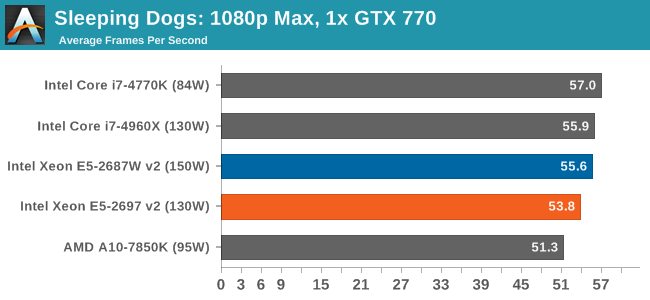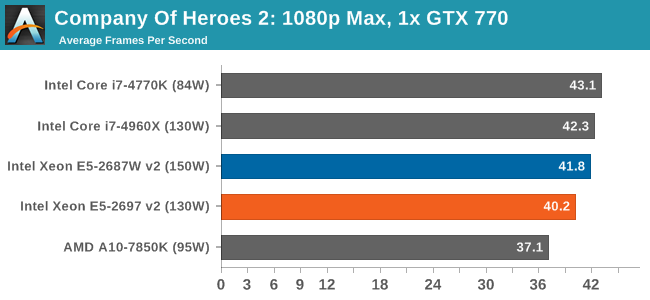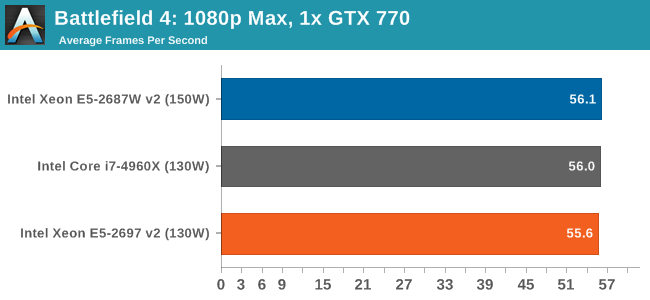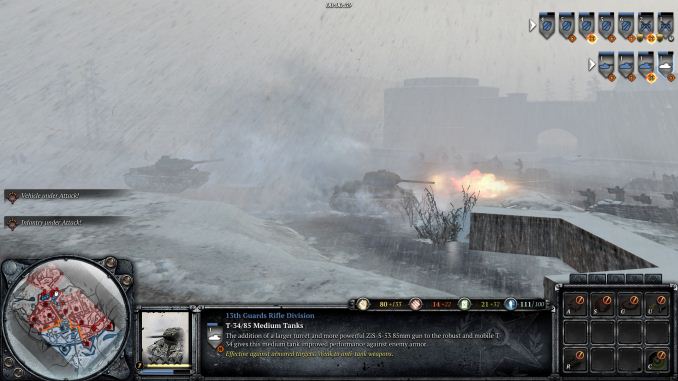Intel Xeon E5-2697 v2 and Xeon E5-2687W v2 Review: 12 and 8 Cores
by Ian Cutress on March 17, 2014 11:59 AM EST- Posted in
- CPUs
- Intel
- Xeon
- Enterprise
Sleeping Dogs
Sleeping Dogs is a benchmarking wet dream – a highly complex benchmark that can bring the toughest setup and high resolutions down into single figures. Having an extreme SSAO setting can do that, but at the right settings Sleeping Dogs is highly playable and enjoyable. We run the basic benchmark program laid out in the Adrenaline benchmark tool, and the Xtreme (1920x1080, Maximum) performance setting, noting down the average frame rates and the minimum frame rates.

| Sleeping Dogs, 1080p Max | ||
| NVIDIA | AMD | |
| Average Frame Rates |
|
|
| Minimum Frame Rates |
|
|
The lower frequency of the 12-core Xeon sometimes puts it behind in our Sleeping Dogs testing, usually in multiple GPU results such as 3x HD 7970 where it is 15 FPS behind both the i7-4960X and E5-2687W v2
Company of Heroes 2
The final gaming benchmark is another humdinger. Company of Heroes 2 also can bring a top end GPU to its knees, even at very basic benchmark settings. To get an average 30 FPS using a normal GPU is a challenge, let alone a minimum frame rate of 30 FPS. For this benchmark I use modified versions of Ryan’s batch files at 1920x1080 on Medium. COH2 is a little odd in that it does not scale with more GPUs.

| Company of Heroes 2, 1080p Max | ||
| NVIDIA | AMD | |
| Average Frame Rates |
|
|
| Minimum Frame Rates |
|
|
COH2 also acts somewhat CPU agnostic, although the higher frequency Xeon does have a small negligable boost over the E5-2697 v2. In all circumstances, the i7-4960X is competitive.
Battlefield 4
The EA/DICE series that has taken countless hours of my life away is back for another iteration, using the Frostbite 3 engine. AMD is also piling its resources into BF4 with the new Mantle API for developers, designed to cut the time required for the CPU to dispatch commands to the graphical sub-system. For our test we use the in-game benchmarking tools and record the frame time for the first ~70 seconds of the Tashgar single player mission, which is an on-rails generation of and rendering of objects and textures. We test at 1920x1080 at Ultra settings.

| Battlefield 4, 1080p Max | ||
| NVIDIA | AMD | |
| Average Frame Rates |
|
|
| 99th Percentile Frame Rates |
|
|
As we add more GPUs, AMD and NVIDIA act differently. With NVIDIA, more MHz gets better frame rates, whereas with AMD more cores wins out.
Conclusions
It would seem that in our gaming benchmarks, the higher frequency E5-2697W v2 is the more obvious choice over the 12-core E5-2697 v2. However in almost all circumstances, they perform on part with or below the i7-4960X, thus suggesting that our games tested cannot take advantage of more threads.












71 Comments
View All Comments
lever_age - Monday, March 17, 2014 - link
Ian, the Xeon E3-1220v3 and E3-1225v3 do not have hyperthreading. They're incorrectly listed in the table as 4c/8t. At those prices, if they did have 8t, more people would be buying them! Also, I think that "c3" by the E3-1230 is a typo.Ian Cutress - Monday, March 17, 2014 - link
Correct, I missed that going through the data.psyq321 - Monday, March 17, 2014 - link
"If the E5-2697 v2 was put in this position, we would have 12 cores at 3.5 GHz, ready to blast through the workload."I do not think this is possible. I have tried to force all cores to turbo mode with ThrottleStop on the 2697v2 Xeon (ThrottleStop bypasses the BIOS/UEFI and codes the limits directly using MSR registers), but the CPU will just refuse to grant this.
I suppose the desktop CPUs simply have this option unlocked, while 2S/4S Xeons have much stricter operating point limits.
The best I can do with 2697 v2 is to set the BCLK to 105 MHz with Z9PE-D8 WS and get 3.15 GHz maximum all-core turbo. This is as much overclock as the system can take.
Ian Cutress - Monday, March 17, 2014 - link
I've managed to get 110 BCLK on both processors relatively stable (112 BCLK needs a push), but this boosts up from the lower multiplier rather than the high one, and there is still a deficit on the high end. Enthusiasts will always want more, and I'd love the chance to run all the cores at the top turbo mode. Given how this is on the consumer line, it makes me wonder why Intel doesn't allow it here. The downside on the consumer line of allowing this behaviour is every so often there is a motherboard that fails to implement any Turbo Core, which has happened in my testing already.psyq321 - Monday, March 17, 2014 - link
I suppose some Intel marketing people just wanted to stop a possibility of lower-end Xeon cannibalizing higher-end Xeons by cheap overclocking. There are markets even in server business that are OK with overclocking (low latency trading, for example).It is interesting that you got it to 110 MHz BCLK. Did you use a server/workstation board or a HEDT (X79) board?
Ian Cutress - Monday, March 17, 2014 - link
This was in the MSI X79A-GD45 Plus, an X79 board. There are some server market areas that do sell pre-overclocked systems in this way, while still using Xeons, if I remember correctly.psyq321 - Monday, March 17, 2014 - link
I think HEDT boards are better when it comes to overclocking, probably due to higher component tolerances.Z9PE-D8 WS is not that good, but then again, it is a 2S board and apart from some Supermicro products (the "hyperspeed" series), the only 2S board that allows at least some overclocking of DDR3 and CPU.
Slomo4shO - Monday, March 17, 2014 - link
I am perplexed by the gaming benchmarks... Any particular reason why the 4770K and A10-7850K don't show up on all of the single and double GPU benchmarks? Especially considering that you have some tri-fire benches of the a10-7850K...Ian Cutress - Monday, March 17, 2014 - link
The AMD does not allow dual NVIDIA cards because the platform does not allow SLI. I need to re-run the 4770K in a PLX8747 enabled motherboard to get 3x SLI results across the board (you cannot get 3x SLI without a PLX chip), and I have not had a chance to run either CPU on my BF4 benchmark which has just been finalised for this review. The A10-7850K and i7-4770K numbers were taken from the Kaveri review and some internal testing - now my 2014 benchmarks are finalised I can run it on more platforms as the year goes on.et20 - Monday, March 17, 2014 - link
Why aren't Xeon E3s the recommended CPUs for enthusiast desktops?They make more sense than the Core i5 and i7 which come with integrated graphics that never gets used.